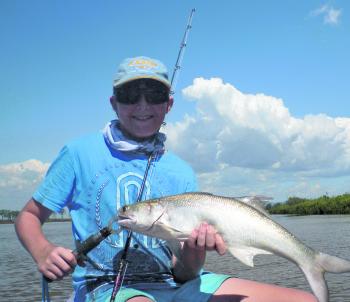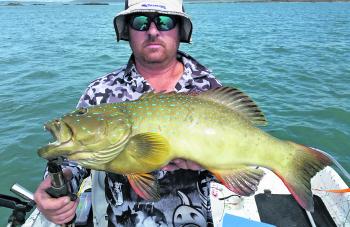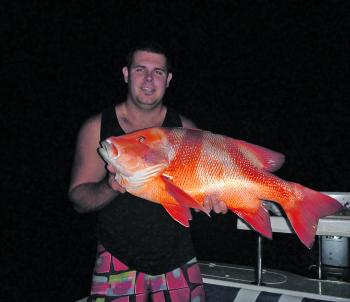Mac tuna and northern blues are making their way into the local waters and should be around as long as the schools of whitebait are here. When you chase tuna it pays to use small streamline chromies, slugs, red and white feather jigs or white marabou jigs.
Plastics also work very well, particularly any that resemble the baitfish they feed on. It doesn’t matter as long as you can cast the lure a fair distance. I’ve seen anglers race toward the school and cause them to scatter out of sight without a fish taken.
Run up wide of the school until you are well forward and just off their line of travel. Then turn the boat off and get ready to cast as soon as they are in range. Cast out across the schools and rip back with speed as fast as you can. On saying that it doesn’t hurt to mix it up a bit by using a decent-sized Flasha or something similar and do the same except let it sink quite a bit longer. If it doesn’t get taken on the drop by a tuna chances are it could get nailed by a doggie or trevally that often hang under the mac tuna or longtail schools collecting the scraps that tuna have left behind.
The noise and movement attracts a whole lot of other fish, and the sink can be quite rewarding at times. By-catch isn’t necessarily a bad thing when it turns into a 4kg doggie or a 10kg Spaniard.
We have some great reefy rubble patches with decent bommies that are serious fish attracters. Forty Acre Paddock and Findlays are two of the better known spots that seem to always have pelagics in numbers. Any school fish that move through the bay will pass by these spots, which makes them a great starting point for small boat anglers. If you don’t like to eat northern blue or haven’t tried it then you are missing out on a great fish for the BBQ. Fillet the fish and take out the darkest meat for future reef baits, then marinade the fillets in a BBQ mix. Let it sit for a while and cook quickly on a hot plate. This will never beat trout or sweetlip as a table fish but it will change a lot of people’s minds and give you something else out of the norm.
Doggie mackerel remain in some quantity everywhere you would expect them to be. Rita Mada, Iron Pot and Farnborough near Yeppoon and all the islands off Emu Park and Keppel Sands are firing at present. The smaller fish are hugging the coastline while the serious-sized doggies have taken the route past Barren and Outer. There are lots of spots in the area that can be fished without needing a boat including the Rosslyn Bay Harbour wall and local headlands. On calm glassy mornings, doggies and schoolies can often be nailed from a land-based position. Float pilchards and cast chrome lures to find the best fish. Spanish have been consistent in close with the larger quantities showing along the contour lines out behind the islands and heading north.
This time of year you also get some top Spaniards at The Pinnacles, Flat and Perforated. The real big fish are usually at Hummocky, Cape Manifold and Double Rocks. Trolling reasonable sized baits has worked well lately although with the quality lures that are available they are often neglected. I find that Spanish will take any sort of lure that reaches the depth they are hanging and can be trolled at around 11km/h or more. I work on the theory that you can cover a lot more ground at a lure’s optimum speed than the very slow troll speeds needed to swim bonito or ribbonfish.
Watson’s leaping bonito are slowly making their way into the local area. As soon as it gets cool these great baitfish start turning up in Keppel Bay. I try and get a stock of them for the coming mackerel season. Little chromies, plastics or feather jigs can all catch bonito and they do respond to berley so any time the schools are about we drop out a steady berley stream to bring them close and entice them to feed.
Grunter have come on again at many of the local spots in the bay and just north. These guys will feed any time the tide flow slows a bit but we always seem to do much better at night than during the day. The Pinnacles, The Rama, Findlays Cave, Quartz, Cape Capricorn and Cape Manifold are all favourite grunter spots and the best times are around the moon whether it be a few days either side of the full or new moon. I keep hearing that the runs of grunter aren’t as regular as they used to be. We have found that they are around a lot more and have caught fish every time the weather has been good enough for an evening run. When the fish are a bit finicky a smaller sinker on the hook, floated back down to the fish can make all the difference. Squid, pilchards and prawns are the favourite bait for the larger offshore grunter. My favourite is definitely big, shelled green prawns. I put two or three pieces on the hook so that the fish can’t get the whole bait in one chomp. Vibes are another option, and so far 40-50mm gold metal vibes have been my choice.
Black jew numbers are growing in the local hotspots and they should only get better as the temperatures drop even further. Large jew in the 10-15kg class are the standard in this region. When we catch them in the shallow waters of Keppel Bay they are as good a fighting fish as you can find. They usually have a couple of runs before coming up to the surface almost spent. For this reason we only take one or two fish for the crew before moving off to target something else. Big fresh bait is the best and a squid/pilchard cocktail does the job. Flesh strips, especially from doggie mackerel are another top bait.
Most of the common reefies are on the chew over winter and reports have been excellent from the closer grounds and the wides out past the shoals. The weather is the most important factor this time of year, so any time the weather is good it’s worth a wide trip. Snapper in the small sizes have already made a show around the islands and when we get a few cold days the bigger fish will move into the rubble patches in the bay. I have a few spots that hold snapper when they are here, including Findlays, Forty Acre, Square Rocks, Ross Reef and Conical. Fish light, well back from the spot and let out a small slow berley stream for best results.
Bream, whiting, salmon, flathead and grunter are all starting to overtake the summer species on the catch list. All the beaches and local estuaries are producing a good feed at present.
Reads: 1579
Brendan Reed with a fine local blue salmon.

Glenn Davis caught this fine coral trout just outside the harbour on a plastic.

Nathan Milner from Slippery Sailor with a decent night red emperor.




